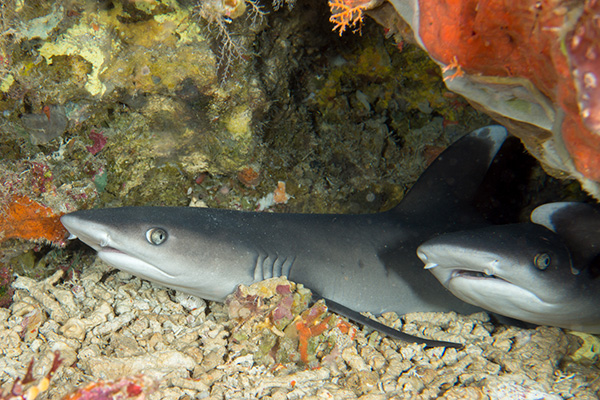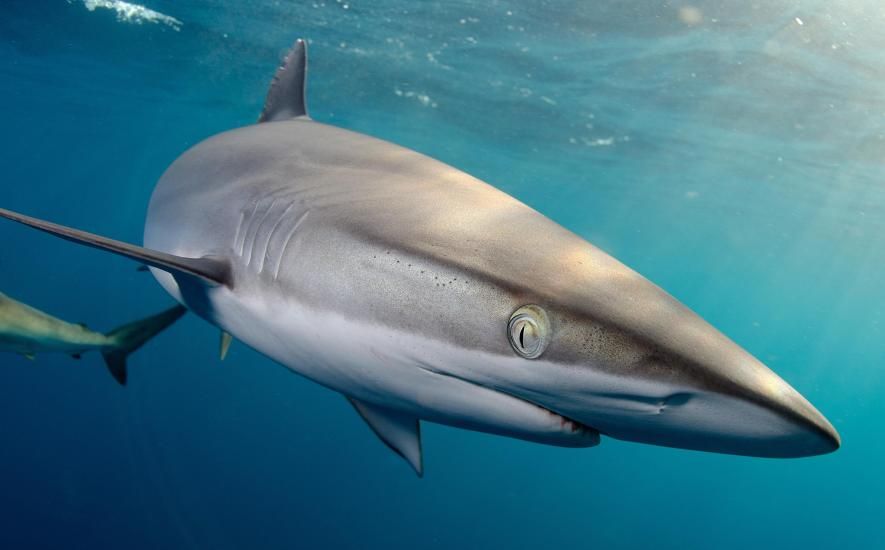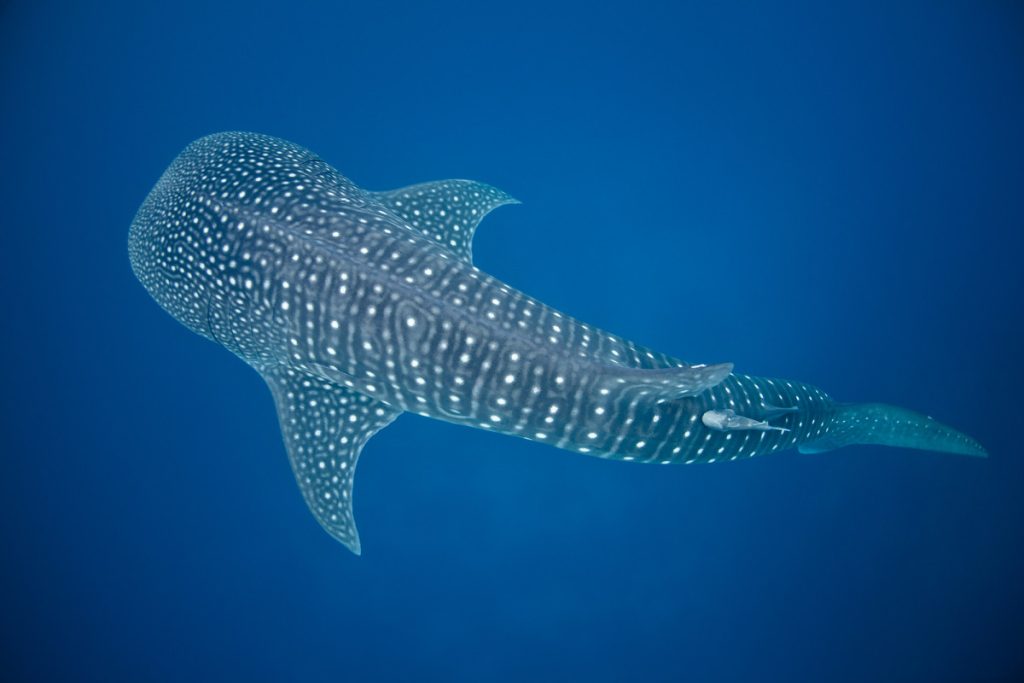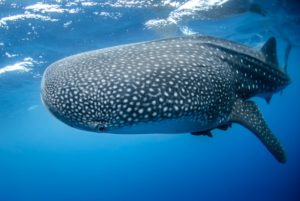Okinawa is an island located in the southernmost part of Japan and is known for its beautiful beaches and clear waters, which make it a popular spot for swimming and diving. The waters around Okinawa are home to a variety of sharks, including some that are considered to be endangered.
The White Tip Reef Shark

The most common shark species found in Okinawa is the Whitetip reef shark (Triaenodon obesus). They are small and non-aggressive shark species and typically found in coral reef environments. They can grow up to 2 meters in length, and are typically gray or brown in color, with a white belly and white tips on their dorsal, pectoral, and caudal fins.
These sharks are relatively non-aggressive and are typically found in small groups or alone. They are active during the day and are known to be curious, often approaching divers and swimmers. They are opportunistic feeders and feed mainly on small fish, crustaceans and cephalopods.
The Whitetip reef shark population is generally considered to be stable, but in some areas, populations have declined due to overfishing and habitat loss. They are listed as near threatened by IUCN red list and are protected in some countries.
Whitetip reef sharks play an important role in coral reef ecosystems as apex predators. They help to control the population of other species, which in turn helps to maintain balance in the ecosystem. However, because of their low reproductive rate, these sharks are vulnerable to overfishing and habitat loss, making it important to protect and conserve these animals.
The Oceanic White Tip Shark
Another white tip but a lot bigger version is the Oceanic white tip sharks. This species of shark are found in the open ocean and are known to inhabit the waters around Okinawa. These sharks are named for their distinctive white tips on their fins, and they can grow up to 6.6 feet in length. They are apex predators and feed on a variety of prey, including fish, squid, and sea turtles

In the past, oceanic white tip sharks were abundant in the waters around Okinawa, but overfishing and accidental bycatch in commercial fishing operations have led to a decline in their population. As a result, the oceanic white tip shark is now considered a vulnerable species by the International Union for Conservation of Nature (IUCN).
Conservation efforts are underway to protect this species, including stricter regulations on fishing practices and the creation of marine protected areas. In addition, research is being conducted on the biology and behavior of oceanic white tip sharks to better understand and protect them.
Despite their reputation as dangerous animals, oceanic white tip sharks are not commonly involved in attacks on humans. However, it is still important to be cautious and aware when swimming or diving in their habitats, as they are wild animals and should be respected as such.
The Grey Reef Shark

The grey reef shark is a common species of shark found in the waters surrounding Okinawa, Japan. These sharks are known for their sleek, streamlined bodies and their grey coloration, which provides excellent camouflage in their reef habitat. They are generally between 1.5 to 2 meters in length and are a top predator in the Okinawan ecosystem, feeding on a variety of smaller fish and invertebrates.
Grey reef sharks are active and aggressive hunters, often hunting in packs to take down larger prey. Despite their reputation as dangerous predators, they are generally not a threat to humans and are considered to be of low risk to divers and snorkelers in Okinawa. However, it is always important to exercise caution when entering the water and to be aware of your surroundings, especially when swimming near known shark habitats.
The grey reef shark is also an important species for local fisherman in Okinawa, as their meat and fins are highly valued in the local seafood market. However, overfishing and hunting of grey reef sharks has led to declines in populations, particularly in areas close to shore. Conservation efforts are underway to protect this species and other marine life in Okinawa, including the creation of marine protected areas and the regulation of fishing practices.
The Silk Shark
The Silky Shark is a species of shark that is found in warm and temperate waters all over the world, including Okinawa, Japan. These sharks are known for their sleek and smooth appearance, hence the name Silky Shark. They can grow up to 3.2 meters in length and weigh around 250 kg. In Okinawa, Silky Sharks are commonly found in the open ocean where they feed on small fish, squid, and crustaceans.

They are known for their opportunistic feeding habits, where they will take advantage of any available food source. These sharks are also known for their migratory behavior, where they travel long distances in search of food and warmer waters.
Silky Sharks are considered as a near-threatened species by the International Union for Conservation of Nature (IUCN) due to overfishing and commercial hunting for their fins, which are considered a delicacy in some countries. In Okinawa, fishing for Silky Sharks is strictly regulated and monitored by the Japanese government to prevent overfishing and ensure their conservation.
The Tiger Shark

The Tiger Shark is a species of shark that is known for its impressive size and predatory behavior. It is one of the largest species of shark in the world and can grow up to 18 feet in length. The species is widely distributed across the world and can be found in oceans near the equator, as well as near the coasts of many countries. The Tiger Shark is especially known for its aggressive behavior, and it is often considered one of the most dangerous species of shark for humans.
Despite its reputation as a dangerous predator, the Tiger Shark is also highly valued for its meat and fins. The meat of the Tiger Shark is considered a delicacy in many countries and is often sold in markets and restaurants. The fins of the Tiger Shark are also highly sought after, as they are used in the traditional Chinese dish known as shark fin soup. This demand has led to overfishing of the species, which has threatened its populations in some areas.
In Okinawa, the local government has taken steps to protect the Tiger Shark and other species of shark that are found in the waters surrounding the island. Fishing regulations have been implemented to reduce the impact of fishing on shark populations, and marine conservation areas have been established to protect important habitats
The Whale Shark
Whale sharks are the largest species of fish in the world, and they can be found in the waters of Okinawa, Japan. These magnificent creatures can grow up to 12 meters in length and weigh up to 12 tons. Despite their size, they are gentle giants, feeding on tiny plankton, krill, and small fish. The whale shark is a slow swimmer and can often be found swimming close to the surface, making them a popular attraction for tourists

Whale sharks are found in tropical and warm waters all over the world and are a popular attraction for divers and snorkelers. They are known for their distinctive pattern of white spots and stripes, which is unique to each individual. They are also very social animals and are often seen swimming in groups.
Despite their size and strength, whale sharks are considered to be vulnerable species, and their population is declining due to overfishing, habitat loss, and accidental bycatch. In many parts of the world, whale shark hunting is illegal, and there are efforts to conserve and protect the species.
In addition to their size and unique markings, whale sharks are also known for their behavior. They are very gentle creatures and are not known to attack humans. In fact, they often approach divers and boats, which has made them a popular subject for study and research. Scientists are still learning about the whale shark’s migration patterns, reproductive habits, and lifespan.
We also wrote an article about Why you shouldn`t dive with Whale Sharks in Okinawa.
In conclusion, the whale shark is a fascinating and unique species that deserves protection and preservation. It is a true gentle giant and a symbol of the beauty and diversity of the ocean. It is important that we continue to learn more about the whale shark and take steps to protect this magnificent creature and its habitat for future generations to admire and appreciate.







